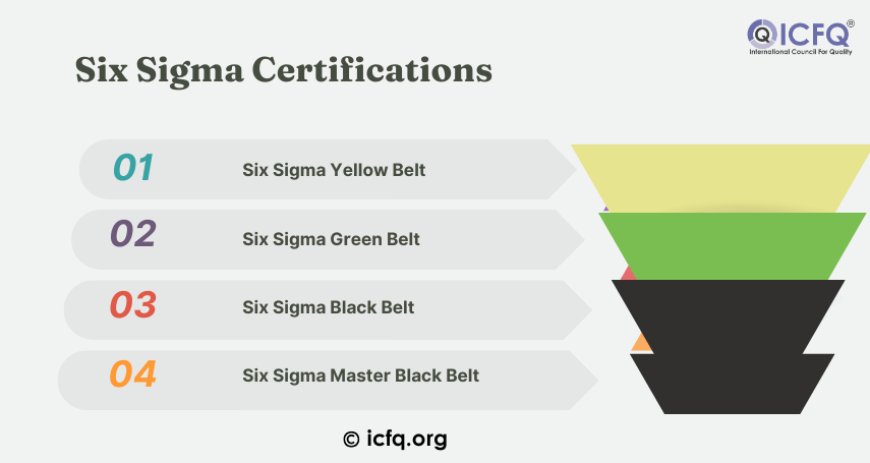Six Sigma Certification Levels and Their Roles
Learn about Six Sigma certification levels (Yellow, Green, Black, and Master Black Belt) and the roles they play in process improvement and quality management

Six Sigma is a proven methodology used by organizations globally to enhance efficiency, reduce defects, and improve the quality of their processes. By relying on data-driven decision-making and statistical tools, Six Sigma helps identify and eliminate process variability. If you're considering a career in quality management or aiming to elevate your organization's operations, understanding the Six Sigma certification levels is key
Introduction to Six Sigma Certification Levels
Six Sigma is not just a methodology—it's a culture of continuous improvement. It empowers businesses to enhance operational efficiency and meet customer demands by minimizing defects in products and services. Six Sigma certifications provide a structured path for professionals to learn, grow, and specialize in this field.
The Six Sigma certification levels range from beginner to expert, offering individuals the opportunity to develop their skills progressively. The levels are as follows: Yellow Belt, Green Belt, Black Belt, and Master Black Belt. Each level builds upon the previous one, with increasing responsibilities and expertise required at each stage.
Six Sigma Yellow Belt: The Foundation
The Six Sigma Yellow Belt is the entry-level certification designed for individuals new to Six Sigma. It provides an introduction to the methodology, covering its basic principles and how it drives process improvement. Typically, Yellow Belt holders play a supporting role in improvement projects, assisting more experienced professionals as they apply Six Sigma techniques.
Role of a Six Sigma Yellow Belt:
-
Learning the Basics: Yellow Belts learn core Six Sigma concepts, including the impact of process improvement on business outcomes and the fundamentals of reducing defects.
-
Supporting Project Teams: While Yellow Belts don’t usually lead projects, they support larger initiatives by gathering data and tracking performance under the guidance of more experienced team members.
-
Data Collection: Yellow Belts assist in collecting and analyzing data to identify areas for process improvement.
This level is perfect for individuals who want to familiarize themselves with Six Sigma but aren’t yet ready to take on full project management responsibilities. It lays a strong foundation for those who plan to advance to higher levels.
Six Sigma Green Belt: Intermediate Expertise
The Six Sigma Green Belt certification is for those who are ready to take on more responsibility in process improvement efforts. Green Belts typically manage smaller projects or work alongside Black Belts on larger, more complex initiatives. This level deepens the understanding of Six Sigma principles and equips individuals with the skills to analyze and improve processes within their organization.
Role of a Six Sigma Green Belt:
-
Managing Projects: Green Belts lead mid-sized projects or play a key role in larger ones, applying Six Sigma tools to identify inefficiencies and improve processes.
-
Data Analysis: Green Belts use statistical methods and process mapping to analyze data, identify trends, and suggest improvements.
-
Collaboration: Green Belts work with Black Belts and Yellow Belts, often managing teams and guiding them through the implementation of process improvements.
The Green Belt certification prepares individuals to take on a leadership role within their organization, ensuring that Six Sigma principles are applied effectively and results are achieved.

Six Sigma Black Belt: Advanced Leadership
The Six Sigma Black Belt certification is for individuals who wish to take on advanced roles in Six Sigma project management. Black Belts are typically responsible for leading large, cross-functional teams and overseeing substantial process improvement initiatives. At this level, individuals develop a deep expertise in Six Sigma methodologies and play a key role in organizational change.
Role of a Six Sigma Black Belt:
-
Project Leadership: Black Belts lead high-impact projects, ensuring that Six Sigma techniques are applied effectively to drive measurable improvements.
-
Advanced Problem Solving: They tackle complex problems by using advanced statistical tools and methodologies to identify root causes and implement sustainable solutions.
-
Mentoring: Black Belts also mentor Green and Yellow Belts, helping them develop their skills and providing guidance throughout their projects.
A Six Sigma Black Belt is a recognized expert in process improvement and is often responsible for managing the most challenging and critical projects within an organization.
Six Sigma Master Black Belt: Expert-Level Oversight
The Six Sigma Master Black Belt is the highest level of Six Sigma certification. Master Black Belts are experts who oversee the strategic direction of Six Sigma initiatives across entire organizations. They play a critical role in mentoring Black Belts, Green Belts, and Yellow Belts while also providing leadership on complex, high-level projects.
Role of a Six Sigma Master Black Belt:
-
Strategic Oversight: Master Black Belts to develop and implement the organization’s Six Sigma strategy, ensuring that projects align with broader business goals.
-
Mentorship: They mentor Black Belts and other Six Sigma practitioners, guiding them in their efforts to implement process improvements.
-
Process Optimization: Master Black Belts focuses on the continuous improvement of critical business processes, often leading the most complex projects that have far-reaching impacts on the organization.
Master Black Belts are responsible for driving Six Sigma excellence across an organization and ensuring the successful application of Six Sigma techniques on a large scale.
Understanding the Six Sigma certification levels is essential for professionals looking to advance in the field of quality management. Each certification level—Yellow Belt, Green Belt, Black Belt, and Master Black Belt—offers unique responsibilities and opportunities to develop expertise in process improvement. As you progress through these levels, you’ll not only enhance your skills but also make a significant impact on your organization’s ability to improve efficiency and reduce defects.
No matter where you start, Six Sigma certifications provide a structured pathway to mastering the methodology and applying it effectively in your career. Whether you're just beginning with the Yellow Belt or striving for the leadership role of a Master Black Belt, each level unlocks new potential for personal and professional growth.
.





























